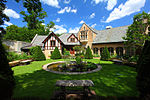The Minikahda Club
Curtis Cup venuesGolf clubs and courses in MinnesotaOrganizations based in MinneapolisSports venues in MinneapolisU.S. Open (golf) venues ... and 2 more
Use mdy dates from April 2022Walker Cup venues
The Minikahda Club is a private country club in southwest Minneapolis, Minnesota. The club is located just west of Bde Maka Ska and is the oldest country club west of the Mississippi River. The clubhouse, which is situated on a high hill, overlooks the lake and has expansive views of the surrounding area and the Minneapolis skyline. Established in 1898 by a group of wealthy Minneapolis families, the club’s golf course, named one of the top 100 classic golf courses in the United States by Golfweek, has been host to several golf tournaments including the U.S. Open in 1916, the U.S. Amateur in 1927, and the Walker Cup in 1957.
Excerpt from the Wikipedia article The Minikahda Club (License: CC BY-SA 3.0, Authors).The Minikahda Club
Excelsior Boulevard, Minneapolis Bde Maka Ska - Isles
Geographical coordinates (GPS) Address Nearby Places Show on map
Geographical coordinates (GPS)
| Latitude | Longitude |
|---|---|
| N 44.943 ° | E -93.322 ° |
Address
Excelsior Boulevard
55416 Minneapolis, Bde Maka Ska - Isles
Minnesota, United States
Open on Google Maps










